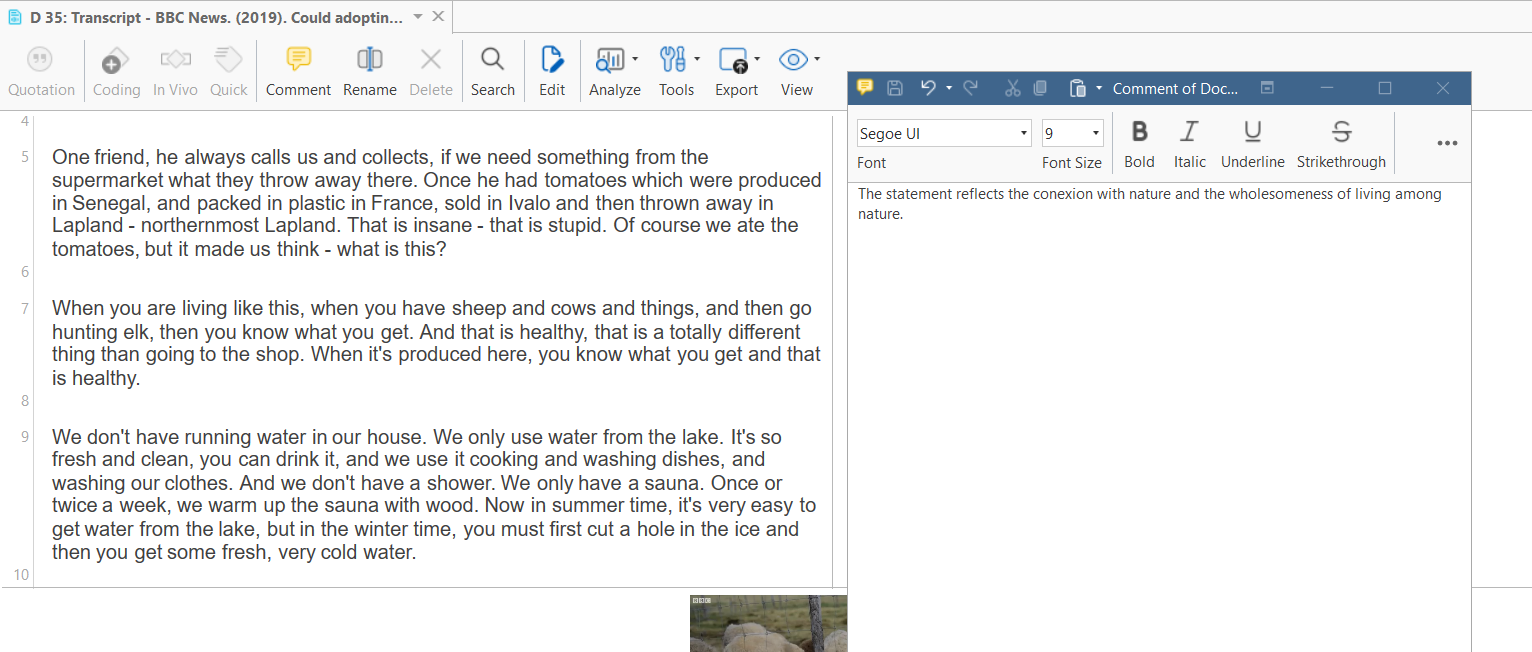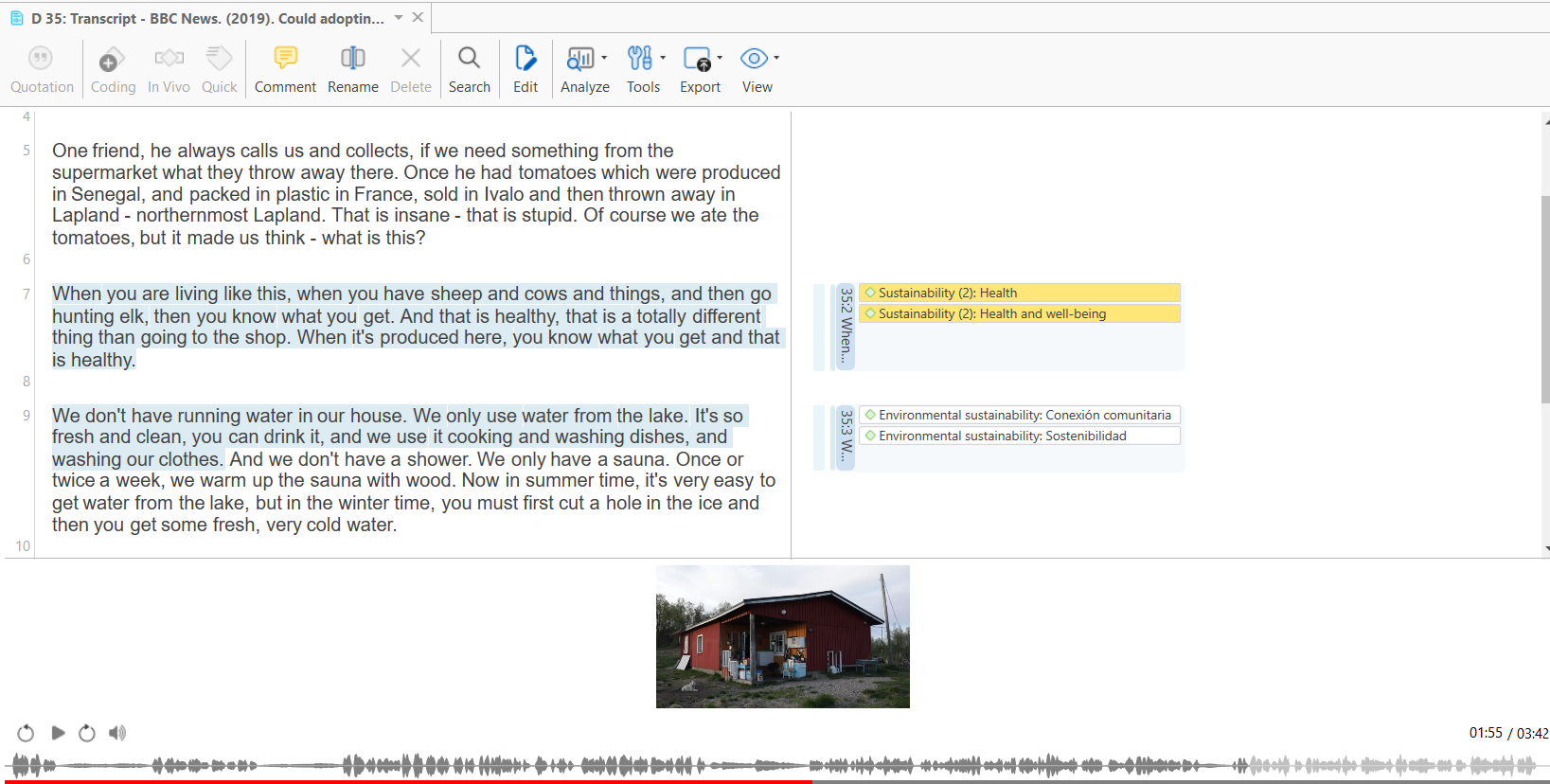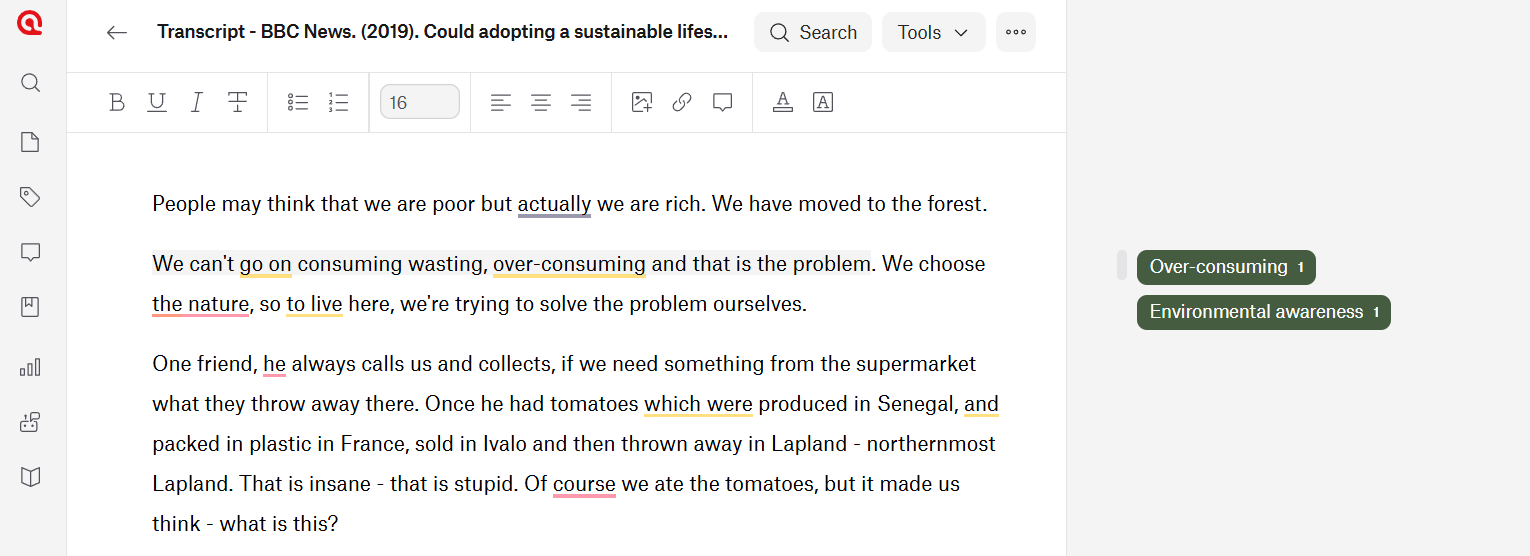- What is Interview Analysis?
- Advantages of Interviews in Research
- Disadvantages of Interviews in Research
- Ethical Considerations in Interviews
- Preparing a Research Interview
- Recruitment & Sampling for Research Interviews
- Interview Design
- How to Formulate Interview Questions
- Rapport in Interviews
- Social Desirability Bias
- Interviewer Effect
- Types of Research Interviews
- Face-to-Face Interviews
- Focus Group Interviews
- Email Interviews
- Telephone Interviews
- Stimulated Recall Interviews
- Interviews vs. Surveys
- Interviews vs Questionnaires
- Interviews and Interrogations
- How to Transcribe Interviews?
- Verbatim Transcription
- Clean Interview Transcriptions
- Manual Interview Transcription
- Automated Interview Transcription
- How to Annotate Research Interviews?
- Formatting and Anonymizing Interviews
- Analyzing Interviews
- Coding Interviews
- Reporting & Presenting Interview Findings
- How to cite "The Guide to Interview Analysis"
How to Annotate Research Interviews?
Annotated interview transcripts serve as a crucial tool in the qualitative research process, particularly during qualitative interview data analysis. They provide researchers with a comprehensive and detailed record of qualitative interviews, including not just the participants' responses but also the researchers' observations, reflections, and initial analysis. This combination of raw data and insightful commentary allows researchers to engage deeply with their data. In this article we will cover all the basics of annotating interviews, including when to annotate an interview, best practices and suggestions on how to use ATLAS.ti for your annotated interview transcripts.

Introduction
Qualitative data analysis, particularly when analyzing an interview transcript, is a multifaceted process that goes beyond simple transcription. It involves coding, identifying critical themes, and reflecting on patterns that emerge from the data during the interview process. For researchers aiming to uncover deep insights, this approach is especially valuable, as it offers a structured way to engage with large datasets and identify meaningful connections.
The interview method plays a central role here, enabling researchers to generate data that is rich and nuanced. Annotated interview transcripts enhance the ability to conduct qualitative analysis by providing a systematic framework for dissecting qualitative data and uncovering deep insights. Moreover, advancements like natural language processing are increasingly integrated into interview analysis, offering more efficient ways to extract patterns and themes from transcripts.
In contrast to quantitative data, which relies on numbers and statistical analysis, qualitative data provides a narrative-driven understanding of human behavior, perspectives, and experiences. In an annotated interview, "annotation" refers to additional notes, comments, or insights added to the transcript of an interview to provide context, analysis, or interpretation of the conversation. Annotated interview transcripts help researchers analyze interview transcripts effectively by offering a structured approach to processing data and facilitating deep insights within the broader qualitative research framework.
When to annotate interview transcripts?
The decision to annotate interview transcripts should be made with the research objectives and overall research process in mind. Annotations typically become relevant during the data collection and analysis phase of qualitative research. Researchers often conduct an initial review of interview transcripts to familiarize themselves with the data. During this stage, the identification of key themes, relevant words, and critical insights begins to take shape, which can be jotted down in annotations.
Annotations can be made when reading and analyzing interview transcripts. For example, after conducting a qualitative interview, the raw data can be overwhelming, especially when working with large datasets that include multiple interviews or focus groups. Annotated interview transcripts help researchers organize the data into manageable segments, allowing them to focus on relevant concepts related to their research questions.
Annotated interview transcripts are particularly useful when researchers want to track nonverbal cues or details that may not be captured in the transcript alone. These could include body language observed in video recordings or emotional inflections captured in audio files. Through annotation, qualitative researchers can capture these subtleties, leading to more insightful analysis.

Preparing your interview transcripts
Before annotating, it's essential to have a high-quality, accurate transcript. Preparing your interview transcripts involves converting audio or video files into a written form, capturing every word, pause, and utterance as accurately as possible. Verbatim transcription is the gold standard in qualitative research, as it ensures that no data is lost or misrepresented.
The process of accurately transcribing interviews involves listening carefully to the recorded interview and ensuring that the text reflects the spoken words of the participants. In qualitative research, even small details like pauses, hesitations, or changes in tone can be important for understanding participants' emotions, thoughts, or intentions. Whether the data is captured through in-person interviews, video calls, or audio recordings, maintaining the integrity of the transcript is essential to avoid any potential data loss.
Transcribing interviews can be time-consuming, particularly when dealing with large volumes of data, such as multiple interviews or focus group discussions. Researchers may opt for transcription software to speed up the process, though manual transcription ensures a greater degree of accuracy. Regardless of the method used, the final transcript should be reviewed thoroughly for errors and completeness before the annotation process begins.
How to annotate interview transcripts?
Annotating interview transcripts involves critically engaging with the text to identify themes, patterns, and insights that are relevant to the research. After transcribing the interview data, researchers should begin the annotation process by conducting an initial review of the transcript. During this review, you should highlight important data segments that relate directly to your research objectives.
A common approach to annotating transcripts is coding. Coding involves assigning specific codes or labels to different parts of the text, often related to recurring themes, key concepts, or responses that stand out. These codes can help to structure the data and make it easier to draw connections between various parts of the interview. For example, in a research project about workplace culture, codes could be assigned to segments related to “communication,” “leadership,” or “employee satisfaction.” Coding qualitative data is an essential step in organizing and analyzing large volumes of text data.
While reading and coding the data, researchers should make additional notes on how these codes relate to the overall research process. This may include reflections on participants’ responses, identifying connections between different parts of the interview, or noting follow-up questions that could clarify certain points. Annotating in this way allows for a deeper exploration of the data and a better understanding of how it aligns with the research objectives.
Annotations should not just focus on the content of the interview but also consider the context. Pay attention to tone, pauses, and emotional responses. These nuances, when annotated, can reveal deeper insights that may not be immediately apparent from the text alone.
How can ATLAS.ti help with annotated transcripts?
ATLAS.ti Desktop and ATLAS.ti Web provide powerful tools for coding transcriptions, making annotated transcriptions highly useful for qualitative analysis. Here's how transcription and coding in both versions can significantly enhance your research:
Transcription and coding in ATLAS.ti Desktop (Windows/Mac)
Multimedia transcription
In ATLAS.ti Desktop, you can transcribe audio and video files directly by importing the media and associating it with a transcript document. This allows you to create time-stamped transcriptions in formats like TXT, RTF, or DOCX, enabling you to jump to specific points in the media by clicking the timestamps in the transcript.
In-depth coding for annotated transcriptions
- You can code specific segments of the transcript to highlight key themes, concepts, or categories. Coding is tied to the timestamps in multimedia transcriptions, letting you easily refer back to exact points in the audio or video that correspond to the coded text.
- Annotations can be added as comments or memos attached to quotations, providing contextual insights and reflections on the coded segments.
- Synchronized transcripts: By synchronizing transcripts with the media, you can click on a coded section and have the corresponding audio or video play automatically, making analysis smoother and more efficient.
Visual representation of codes
Codes applied to the transcript are displayed in the margin area, offering a visual representation of concepts distributed throughout the document. This annotation in the margins helps keep track of which segments have been analyzed and what themes have emerged.

Transcription and coding in ATLAS.ti Web
Real-time collaboration and annotating transcriptions
ATLAS.ti Web allows users to upload transcriptions and apply codes to specific sections of text. It supports real-time collaborative annotation, which is useful for team projects where multiple researchers need to work together. Each team member can code and annotate the transcription, with changes being visible to others in real time.
Interactive and collaborative coding
With ATLAS.ti Web, multiple users can code the same transcription simultaneously. Annotations such as memos or comments can be added to the codes, which can then be reviewed and further analyzed by the team. While you cannot synchronize transcripts with media directly in ATLAS.ti Web, the coding and annotations still provide a rich structure for analyzing text-based transcriptions.

How coding enhances annotated transcriptions
- Traceability and depth: Coding transcripts adds traceability and structure to your qualitative research. Each code represents a theme, concept, or category, and the attached annotations add depth to these codes by explaining the rationale behind coding decisions. This makes the analysis systematic and transparent.
- Improved analysis of qualitative data: By coding and annotating transcripts, you can categorize large volumes of data, making it easier to retrieve and analyze patterns or trends across multiple transcripts. Coding helps researchers make sense of complex qualitative data by identifying recurring themes.
- Enhanced focus for report generation: With coded transcriptions, generating reports becomes more efficient. You can export sections of the transcription alongside the codes, which helps in highlighting key findings for research papers or presentations. The organized data can be used to support evidence in qualitative analysis.
In both ATLAS.ti Desktop and ATLAS.ti Web, transcription and coding transform raw qualitative data into a well-organized, searchable, and analyzable resource. While ATLAS.ti Desktop excels with features like multimedia transcription synchronization, ATLAS.ti Web offers real-time collaboration, making both versions highly effective for different research needs. Annotated transcriptions, enhanced with codes and memos, are invaluable tools for qualitative analysis, allowing for deep, insightful analysis that informs your research findings.
Best practices for annotated interview transcripts
When annotating interview transcripts, certain best practices can help ensure that the process is both thorough and effective. First, it is essential to use a reliable transcription method to ensure the accuracy of the transcript. Manual transcription, while more time-consuming, is often more precise than automatic transcription software. If using software, always review the transcript for errors.
Second, coding the data in a systematic way is key. Researchers should develop a coding table to organize themes and concepts. This will allow for a more structured analysis and help avoid becoming overwhelmed by large datasets. Thematic analysis, for instance, is one of the most effective methods for organizing qualitative data and identifying recurring themes across different interviews.
Another best practice is to avoid letting preconceived notions influence the annotation process. It's important to approach the data with an open mind and be willing to adapt initial insights based on what emerges from the transcripts. Annotating interview transcripts should be an iterative process. Start with an initial review to highlight obvious patterns, then revisit the transcript multiple times as new insights emerge.
Finally, qualitative research analysis often benefits from triangulation—comparing different data sources to ensure that the insights gained from the interview transcripts are consistent with other types of data. For instance, you may compare interview transcripts with observational data or document analysis to develop a more comprehensive understanding of the research topic.
Conclusion
Annotated interview transcripts are an indispensable tool in qualitative research, offering researchers a way to engage deeply with their interview data. Through annotations, researchers can identify key themes, track relevant insights, and develop a comprehensive understanding of the qualitative data. The process of annotating interview transcripts—starting with accurate transcription, coding, and adding insightful commentary—helps to ensure that the data analysis is both thorough and meaningful.
Whether you are conducting interviews for a market research project, exploring qualitative methods for a research paper, or simply aiming to gain deeper insights into your research topic, annotating interview transcripts is a critical part of the process. By following best practices such as coding systematically, avoiding preconceived notions, and ensuring accurate transcription, researchers can analyze interview transcripts effectively and gain valuable insights from qualitative data.
In conclusion, annotated transcripts provide the framework for insightful analysis, transforming raw interview data into actionable knowledge. As a researcher, developing this skill will allow you to generate more reliable, comprehensive findings that contribute significantly to your field of study.




